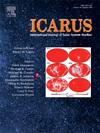在土星赤道日面电离层-原位观测提供了一个动态和分层结构的不平衡的证据
IF 2.5
2区 物理与天体物理
Q2 ASTRONOMY & ASTROPHYSICS
引用次数: 0
摘要
卡西尼号对土星电离层的观测在近轨道288-293在海拔1450-4000公里(高于1巴水平)。对无线电的所有159个可用的朗缪尔探针扫描进行了彻底的重新分析。等离子体波科学(RPWS)测量。我们将它们与RPWS等离子体波推断的电子数密度联系起来,并将它们与离子中性质谱仪(INMS)测量的H+和H3+数密度进行了比较。RPWS采用不同的分析方法,为整个测量高度区间提供一致的电子数密度值。在海拔~2200 km以上得到了一致的RPWS电子数密度(ne)和INMS正电荷离子数密度(ni+)分布图。在这个高度以下,INMS无法在34公里/秒的飞越速度下测量8阿姆以上的离子,这使我们推断存在重离子(>;8amu)和带负电荷的离子成分,可能与来自土星d环的物质及其相关的局部离子-分子-气溶胶化学有关。这一较低海拔地区呈现出高度时变的层状结构。当以34公里/秒的速度穿越富含分子的大气层时,该区域的Langmuir探测器数据受到航天器和传感器表面发射的二次辐射的强烈影响。数据中有来自航天器和传感器表面的二次电子和离子发射的清晰信号。在Langmuir探针扫描分析中,我们校正了这种撞击产生的产物的影响。这给出了校正后的总离子数密度,可以与INMS离子数密度和电子数密度进行比较。从这个分析可以限制负离子和/或纳米大小的气溶胶/尘埃颗粒的数量。没有明确的电离层峰值,甚至在观测到的最低高度约1450公里处也没有。有明显的纬度变化和时间演化结构,我们推断这是来自d环不同区域的物质流入差异的代表。此外,有迹象表明,环境电子的强热源远高于预期的热平衡水平(高达4000 K)。这种加热的原因尚不清楚,但可能与坠落环物质的碰撞减速有关。这里提供的观测资料将来可用于电离层理论/模式的比较。本文章由计算机程序翻译,如有差异,请以英文原文为准。
On the equatorial dayside ionosphere of Saturn – In-situ observations give evidence for a dynamic and layered structure in disequilibrium
The Cassini observations of Saturn's ionosphere during the proximal orbits 288–293 in the altitude range 1450–4000 km (above 1-bar level) are revisited. A thorough re-analysis is made of all 159 available Langmuir probe sweeps of the Radio & Plasma Wave Science (RPWS) measurements. We relate them to the RPWS plasma wave inferred electron number densities and compare them with the available Ion Neutral Mass Spectrometer (INMS) measurements of the H+ and H3+ number densities. Different analysis methods are used by RPWS to provide consistent electron number density values for the whole measured altitude interval. Consistent RPWS electron number density (ne) and INMS positively charged ion number density (ni+) profiles are derived for altitudes above ~2200 km. Below this altitude the inability of INMS to measure ions above 8 amu at the 34 km/s flyby speed lead us to infer the presence of heavy ions (> 8 amu) and a negatively charged ion component, presumably related to infalling material from the D-ring of Saturn with its associated local ion-molecule-aerosol chemistry. This lower altitude region shows a highly time variable layered structure. The Langmuir probe data in this region are strongly affected by secondaries emitted from the spacecraft and sensor surfaces when traversing a molecule-rich atmosphere at 34 km/s. There are clear signatures of secondary electron and ion emissions from the spacecraft and sensor surfaces in the data. In the Langmuir probe sweep analysis, we correct for the effect of such impact-generated products. This gives corrected total ion number densities that can be compared to the INMS ion number densities and the electron number densities. From this analysis the number of negative ions and/or nm-sized aerosol/dust particles can be constrained. A clear ionospheric peak is not identified, not even at the lowest observed altitude of approximately 1450 km. There are clear latitudinal variations and temporal evolving structures, which we infer are representative of the difference in infalling material from different regions of the D-ring. In addition, there are indications of a strong heating source for the ambient electrons that are well above expected thermal equilibrium levels (up to 4000 K). The cause of this heating is unknown but may be linked to collisional deacceleration of infalling ring material. The observational profiles presented here can be used for ionosphere theory/model comparisons in the future.
求助全文
通过发布文献求助,成功后即可免费获取论文全文。
去求助
来源期刊

Icarus
地学天文-天文与天体物理
CiteScore
6.30
自引率
18.80%
发文量
356
审稿时长
2-4 weeks
期刊介绍:
Icarus is devoted to the publication of original contributions in the field of Solar System studies. Manuscripts reporting the results of new research - observational, experimental, or theoretical - concerning the astronomy, geology, meteorology, physics, chemistry, biology, and other scientific aspects of our Solar System or extrasolar systems are welcome. The journal generally does not publish papers devoted exclusively to the Sun, the Earth, celestial mechanics, meteoritics, or astrophysics. Icarus does not publish papers that provide "improved" versions of Bode''s law, or other numerical relations, without a sound physical basis. Icarus does not publish meeting announcements or general notices. Reviews, historical papers, and manuscripts describing spacecraft instrumentation may be considered, but only with prior approval of the editor. An entire issue of the journal is occasionally devoted to a single subject, usually arising from a conference on the same topic. The language of publication is English. American or British usage is accepted, but not a mixture of these.
 求助内容:
求助内容: 应助结果提醒方式:
应助结果提醒方式:


